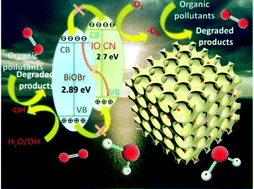Z-scheme inverse opal CN/BiOBr photocatalysts for highly efficient degradation of antibiotics†
Abstract
Optimizing the heterojunction structure of semiconductor photocatalysts is vital for utilizing their abilities in organic matter degradation. Herein, a novel fabrication of a Z-scheme system with inverse opal g-C3N4 and BiOBr via a reflux process is developed. On the one hand, the unique inverse opal construction, formed by using silica (SiO2) photonic crystals as the template, not only provides a larger surface area for adsorption of antibiotics but also improves the separation and transfer efficiency of photogenerated electrons and holes as well as visible light absorption ability. On the other hand, by imitating natural photosynthesis, the artificial Z-scheme system with an inverse opal g-C3N4–BiOBr nanojunction further promotes the separation of photogenerated electrons and holes. The obtained IO CN/BiOBr catalyst exhibits superior photocatalytic performance for antibiotics degradation under visible light irradiation. In a typical test, almost complete degradation of levofloxacin (LVX) (10 mg L−1) could be achieved within 50 min due to the proper bandgap match between inverse opal g-C3N4 and BiOBr as well as enhanced surface area and light absorption. The present work provides an alternative strategy for construction of novel visible-light-driven Z-scheme photocatalysts and offers some new insights into the methods of waste water treatment.

- This article is part of the themed collection: 2019 PCCP HOT Articles


 Please wait while we load your content...
Please wait while we load your content...